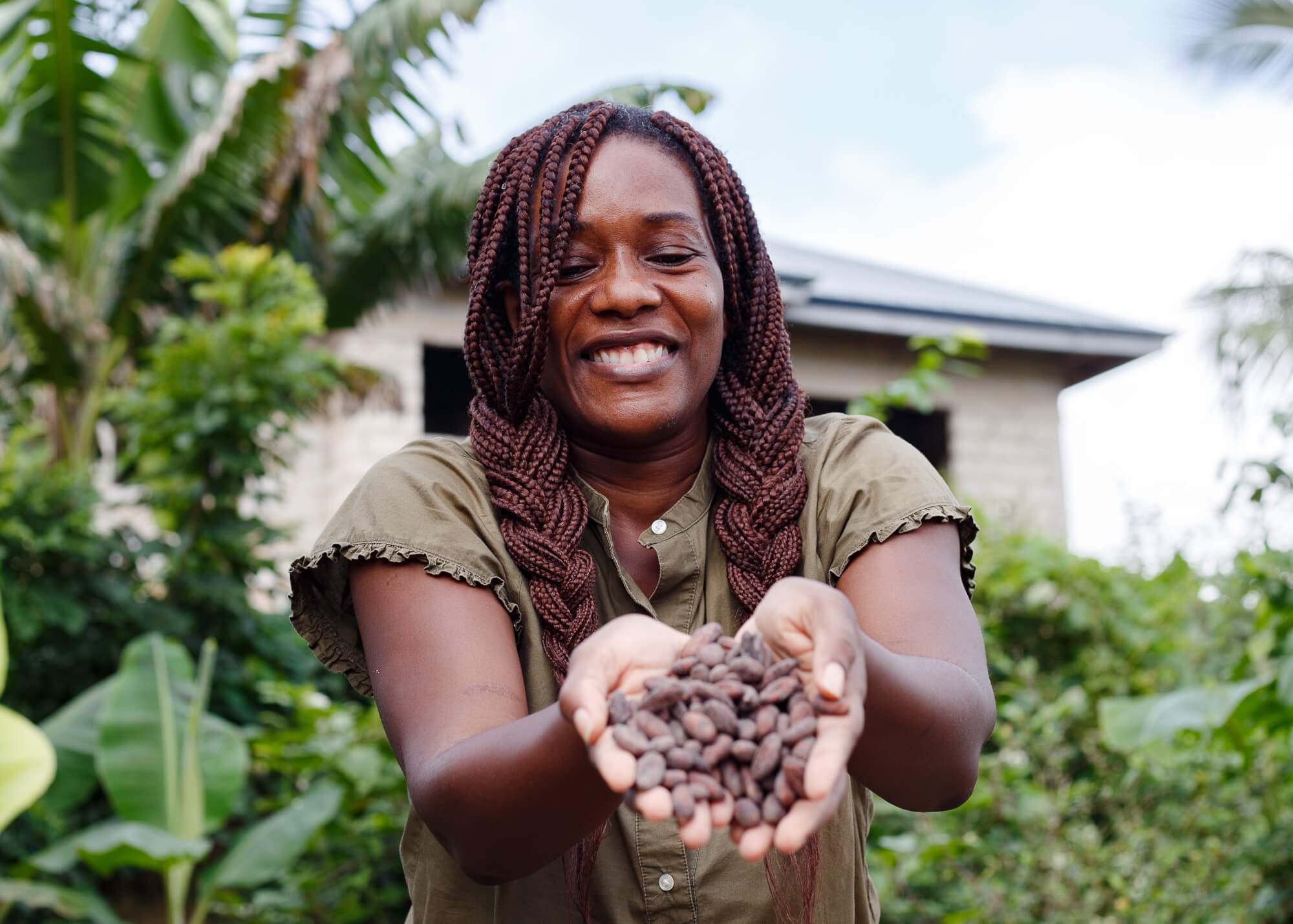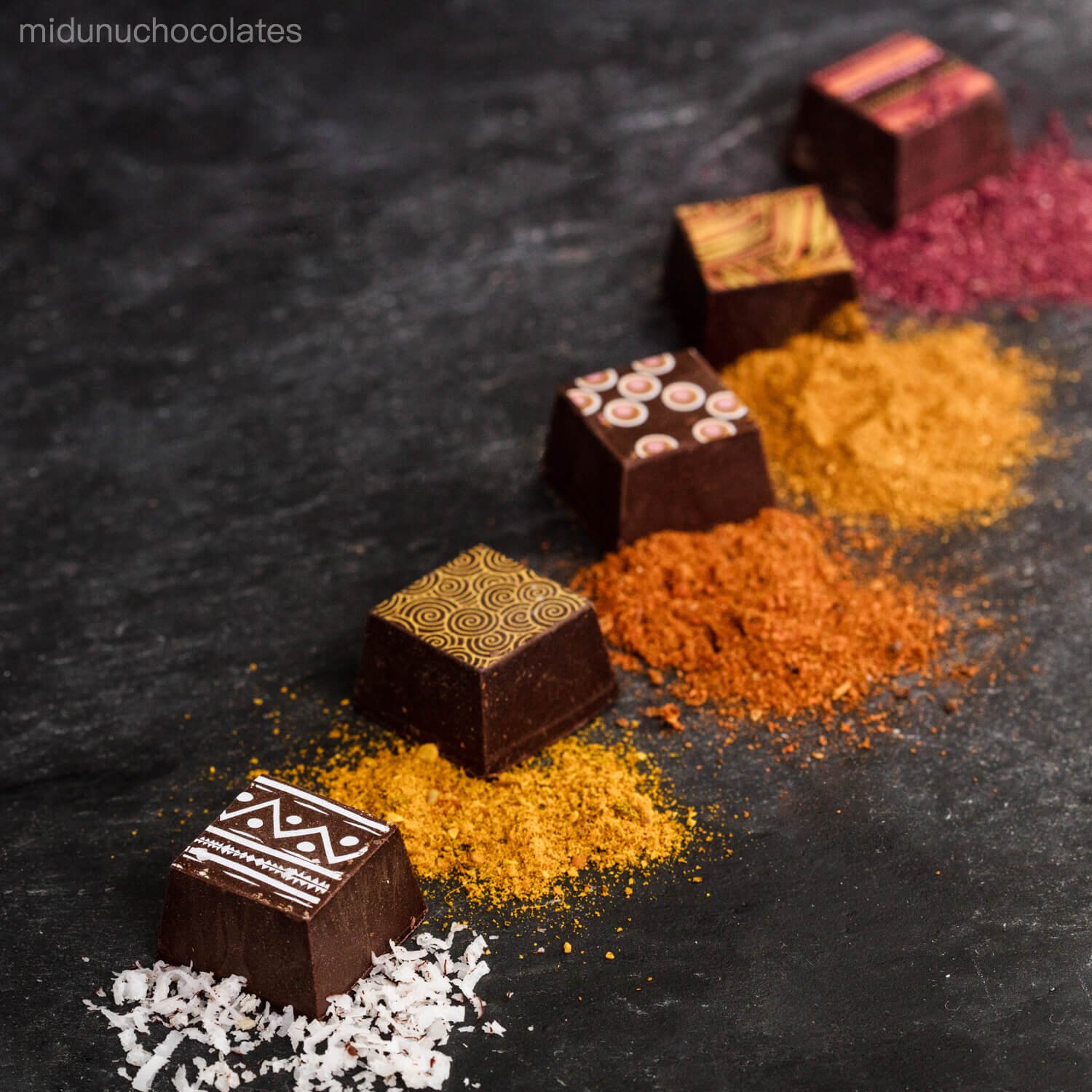How Midunu Chocolates Elevates Ghanian Cocoa & Celebrates its Culture
Cocoa is not native to Ghana, but it is currently one of the largest producers of cocoa beans worldwide, second only to next door neighbor Côte d’Ivoire. These top two countries, in fact, produce more cocoa combined than the remaining countries that make up the top 10 list of cocoa production. “What people know as the taste of chocolate is actually the West African terroir,” says Selassie Atadika, founder of Midunu Chocolates. (Pronounced “ME-doo-noo.”)
“People mostly think of Ghanian chocolate as bulk chocolate; that it’s not fancy chocolate, but what’s interesting is that the entire process is hand made,” says Atadika. “I think when you see this process of small family farms that are doing this at a household level, and then processing it and getting it all done by hand…everywhere else in the world you would actually end up spending a lot more money for it.”
Formerly a humanitarian worker for the United Nations, Atadika founded Midunu as a purpose built brand born to address the misconception of Ghanian chocolate: to elevate the perception of its cocoa while contributing to its economic growth, as well as that of other important Ghanian and African products.
Ghana’s Chocolate History
That cocoa is Ghana’s most valuable cash crop is especially striking considering that it didn’t come to the country until the second half of the 19th century, arriving via a Ghanian tradesman who had been sent to Equatorial Guinea to work as a blacksmith. (The poetry of a blacksmith being ultimately responsible for crafting another dark-colored material in Ghana is not lost here.)
Planted away from the coast in higher altitude, forested areas, cocoa became successful quickly in Ghana through the machinations of colonialism, doubtlessly fueled by increasing Victorian demand for chocolate. By the 1960s, less than 100 years after the arrival of cocoa in the country, Ghana was the world’s largest producer of chocolate. A unique element to Ghana’s cocoa production, according to Atadika, is that the pulp and seeds of the cocoa beans are wrapped in banana or plantain leaves for the fermentation stage. “I believe the banana leaves are what gives the beans from Ghana a unique flavor,” she says.
So important is cocoa production to Ghana’s overall economy that it is impossible to buy directly from those who grow and process it. A governing board buys processed cocoa beans directly from farmers, which controls the price. “In many ways that can be good (for Ghana’s farmers,)” says Atadika. “If the price of cocoa on the world market drops below the living wages, the government provides a subsidy to put that price higher, so that the farmers can get a better price if the market is flooded with beans, and the price drops.”
Giving Rise to Midunu Chocolates
Both Atadika’s work with the UN and with chocolate were fueled by humanitarian causes. “I just kept seeing food being something that was linking people together, whether it was them sharing a table, or whether it was a way for them to solve social problems, or it was part of the social issue,” she says. “I just felt that it was important to dig deeper into food and see how to bring people together and sort of solve some of the challenges that we have in the continent through food.”
Initially, Atadika put this ethos to work as a chef, focusing on dinners that celebrated Ghanian ingredients and could give new life and a new economy to those products. Chocolate truffles spotlighting Ghanian chocolate and other flavors were included at the end of the meal, but that was where Atadika’s chocolate making experience began and ended, prior to — you guessed it — 2020. “People had started asking for the truffles outside of the dinners,” says Atadika, “and when 2020 hit, I was able to pivot and put more energy into it. When we first started, I really was like, sure we can make chocolates, you know, can't be that hard. But the devil is in the details, and I have really learned a lot more about chocolate and the challenges and the joy of this amazing bean.”
Despite it already being a huge part of Ghana’s economy, once invested, cocoa turned out to be just the right fit for Atadika in terms of being able to influence the value chain both for Ghanian cocoa and other African products and crops. “About 2% of the sales of a bar of chocolate is actually what goes back to the farmer,” she says. “When you look at the rest of the value chain, what happens is most of the money leaves the country with the beans. So by adding value in-country we're starting to change the labor economy around cocoa.”
Ghanian and African Culture in Truffle Form
For Atadika, Midunu was always about being able to add value to other Ghanian and African products, not only cocoa, and her unique truffle flavors reflect exactly that: spiced hibiscus, chai, ginger, coffee and cardamom, and Cape Malay curry, among others.
Atadika sources her chocolate couverture from Yayra Glover, a Ghanian cooperative that supports organic farming, Fair Trade principles, and traceability, all elements that were important to her in trying to elevate not only the perception of quality in Ghana’s cocoa, but also its labor and farming practices. The center of each of Midunu’s truffles is essentially an infused ganache, where she uses her chef skills to apply Ghanian spices and flavors to the cream element.
While many chocolatiers rely on transfer sheets to impart delicate designs on their chocolates, Atadika does so with designs she created with help of a graphic designer that evoke specific African fabric patterns. “For each truffle the design usually has to do with the country where the truffle is coming from. That's part of the story that we're trying to get people to understand — not just the flavors, but also a bit more about the cultures from the countries where these truffles are from.”
Finally, each truffle is given the name of an important woman, whether a friend of Adatika’s, or an influential or historical figure. “A lot of women in the culinary space anywhere in the world can get written out of our stories, but they're also the ones that are the culinary custodians for a lot of our heritage,” says Atadika. “So I wanted to find a way to honor and respect them.”




